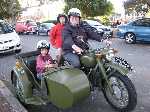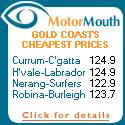1966 Yamaha YDS3 "Catalina" 250cc Two-stroke parallel twin
February 1966 until 1969
My second brand new bike and my first sidecar [see Road Test]

 The
photograph on the right shows me, with the pudding-basin helmet of those days, riding out
of the back yard in about 1966. This photo was taken at our home at 166 Victoria
Street, Ballarat, shortly after the bike was purchased. The colour shot, taken at
the rear of The Vicarage, Warrenheip Street, Buninyong, in 1967, shows that our family cat
found the YDS3 to be an ideal mount.
The
photograph on the right shows me, with the pudding-basin helmet of those days, riding out
of the back yard in about 1966. This photo was taken at our home at 166 Victoria
Street, Ballarat, shortly after the bike was purchased. The colour shot, taken at
the rear of The Vicarage, Warrenheip Street, Buninyong, in 1967, shows that our family cat
found the YDS3 to be an ideal mount.
The YDS3 was faster, stronger, stouter; it was somehow a much more satisfying motorcycle. But there was something missing. At every motorcycle rally I would see a few, a very few, riders with sidecars. Now whenever I went out for a ride I would take with me whatever I could. I learned to fill the pockets of my flying suit with everything I just might need on the way. I would do this until my pockets were absolutely full. If I strapped a pack onto the carrying rack at the back, I could bring more stuff. This was duly done until there was no room to attach anything else to the carrying rack! Panniers were fitted. I soon discovered that panniers could hold a lot of stuff. I filled 'em up until they were full! I began to look enviously at sidecars.
I shall divert here slightly from discussing the YDS3 to discussing the various sidecars which ran alongside it.
The 1946 Dusting Sidecar discussion which was here has now moved to a new page.
1966: 1966 Yamaha YDS3 250cc Two-stroke parallel twin (Continued)
Now, after the sidecar diversion, ... back to discussing the Yammy!
The first word that comes to mind is "Reliability". Its one Achilles heel was its rear drive chain. Especially after the sidecar was fitted, the sprockets and chain seemed to last no time at all. This was at least in part due to the fact that I would much rather ride it than maintain it. Still I used to cook the chain on Mum's stove in a mixture of lard and Molybdenum Disulphide on a regular basis. While I was cooking the chain regularly, it lasted longer; when I overlooked it, it would very rapidly wear away.
 The Speedometer and
tachometer were combined in a single instrument which was set into the headlight shell and
worked very well.
The Speedometer and
tachometer were combined in a single instrument which was set into the headlight shell and
worked very well.
An early modification to the YDS3 was to add a full fairing. I had watched these gradually coming into use at road racing meetings, and decided to find out what one would cost. I contacted Pratt & Osborne and they made a replica of the one on Allan Osborne's works Yamaha racing bike. Then they cut a hole in the front and put a perspex disc in there for the headlight to shine through. Some mountings were made up and it was fitted and away I went. I like to imagine that it actually went faster. It felt like it was going faster, but that impression was probably largely due to the huge increase in engine noise that was reflected up at me. My Dad did not approve of the fairing ... after all, in his day everyone rode what we now refer to as "naked bikes". But I rode around with it for a year or two anyway.
 The First Bingle... One
day, the Ballarat Rovers' Motorcycle
Club, of which I was a member, went out on a ride to Korweinguboora.
Korweinguboora was the site of our annual "Scramble championships". The
word "Scramble" in those days stood for what is now called "Motocross"
... the word "motocross" had then not yet been invented. We were
travelling out towards the track to do some work on it to prepare for an upcoming Scramble
meeting. At a left-handed corner on the road through the bush on the way, there was
just a nice scatter of round gravel stones over the surface of the bitumen. I had
somebody on the back as pillion passenger, perhaps my sister, Karen, or perhaps
another club member, I can't recall now, and upon hitting the gravel with the bike leaning
beautifully into the corner, those little gravel stones started rolling away from under
the tyres and I "lost it" and ended up dropping my bike on its side in the
bush. I ended up being taken to Ballarat Hospital in Ballarat to have my top lip
stitched back on, and Alwyn Sobey and others picked up my bike and took it home.
While I re-built the bike it lived right beside my bed in the front bedroom at Victoria
Street ... see picture at right. The bike suffered cracks to the fairing which I
tried to patch up myself, but it kind of never looked quite the same again.
The First Bingle... One
day, the Ballarat Rovers' Motorcycle
Club, of which I was a member, went out on a ride to Korweinguboora.
Korweinguboora was the site of our annual "Scramble championships". The
word "Scramble" in those days stood for what is now called "Motocross"
... the word "motocross" had then not yet been invented. We were
travelling out towards the track to do some work on it to prepare for an upcoming Scramble
meeting. At a left-handed corner on the road through the bush on the way, there was
just a nice scatter of round gravel stones over the surface of the bitumen. I had
somebody on the back as pillion passenger, perhaps my sister, Karen, or perhaps
another club member, I can't recall now, and upon hitting the gravel with the bike leaning
beautifully into the corner, those little gravel stones started rolling away from under
the tyres and I "lost it" and ended up dropping my bike on its side in the
bush. I ended up being taken to Ballarat Hospital in Ballarat to have my top lip
stitched back on, and Alwyn Sobey and others picked up my bike and took it home.
While I re-built the bike it lived right beside my bed in the front bedroom at Victoria
Street ... see picture at right. The bike suffered cracks to the fairing which I
tried to patch up myself, but it kind of never looked quite the same again.  Hovever, I had learned something
very positive about a fairing ... they save your bike from lots of damage in a
bingle. As far as I can remember, I think that this was my first real accident on a
motorbike ... it wasn't to be my last ... The photo at right shows the fairing which
I had repaired by hand after the bingle. My brother Mick is on his Triumph-AJS 500cc
single scrambler beside it.
Hovever, I had learned something
very positive about a fairing ... they save your bike from lots of damage in a
bingle. As far as I can remember, I think that this was my first real accident on a
motorbike ... it wasn't to be my last ... The photo at right shows the fairing which
I had repaired by hand after the bingle. My brother Mick is on his Triumph-AJS 500cc
single scrambler beside it.
The "hand stand" stunt... Now in the early days of this bike, while it was still solo, it had a good pair of leather panniers at the rear. They were in excellent condition until ... about a week after the above bingle. One of the casualties from the bingle had been my handlebars. I immediately ordered a new set, but in the mean-time I borrowed a set of straight and very narrow handlebars from George Langley. Now previously I had this bike pretty well figured out ... if the handlebars would fit through the hole, then so would the rest of the bike including the panniers. I went out for a ride to try out my temporary bars and when I got back home, Dad's Holden Station Sedan was parked in the driveway, it's rear being exactly level with a gatepost attached to a kind of dividing fence down towards the rear of the drive. Now my thinking was, if the handlebars went through, then the rest would follow, right? Wrong! I'm not sure how fast I was going, but those panniers were pretty full of stuff and were a good five or six cm wider than the bars. Now if there was no reason to slow down, why should I? Suddenly, most unexpectedly, I found myself doing a perfect handstand on the handlebars. According to my sister Julie, who was watching this stunt unfold, I seemed to hang there for what seemed an age doing this perfect hand stand and then, ever so slowly, I toppled over and landed in a heap on the ground in front of the front wheel. When I picked myself up wondering what the heck had happened, there stood my Yamaha, undamaged, engine stalled, and tightly wedged upright between the rear of Dad's Holden and the gatepost. Er, ... I then had to go up to Delima's sadlery and leathergoods shop and get the seams of my pannier bags re-stitched.
The Yamaha Wine Maker... Talking about those panniers reminds me of the day I learned not to carry grapes on motorbikes. I stopped for a rest in Horsham and bought some fruit to eat. The grapes were beautiful, so I decided to buy an extra few pounds and take them home to Mum and the kids. In my left pannier already were my tool roll full of heavy tools, a spare set of new spark plugs, a spare tube and tyre-changing kit, a heavy "Hunter" lantern (big six-volt torch), and a myriad of other odds and ends that usually lived there. I put the brown paper bag full of grapes in on top of the rest of the stuff and headed off towards Ballarat. I stopped for petrol somewhere and the bloke who was filling my tank said, "looks like you have a bit of a leak back there, mate!" and pointed at my left pannier where there was a steady drip, drip, drip, of some evil-looking black liquid which was making a pool on the service station driveway. I quickly opened the pannier and there, on top of everything else, was a ripped and soggy brown paper bag with absolutely nothing in it. Under the remains of the bag and on top of all my tools and stuff were a couple of those stripped bare "trees" of grapevine twigs that are normally left over after you have had a really good feed of grapes. As I lifted out my tool roll, torch, tyre levers and stuff, there were a few more of these little bare trees amongst the stuff. I realised I couldn't do a thing about it then and there and continued home to Ballarat. There I removed the left pannier and emptied it out. Every tool and every item in that pannier had become saturated with grape juice. I put the pannier in the kitchen sink and scrubbed it out and hung it out on the clothes-line to dry. Every single tool had then to be cleaned of this sticky mess, dried off and returned to the tool rolls and things which themselves had to be all thoroughly scrubbed and hung out to dry. I think it took me several days before my pannier and its tool kits were back to normal. And never again have I bought any fruit that was softer than an apple and carried it any distance in my panniers. All the Rovers knew I was a teetotaler, but they had great fun calling me names lile "Winemaker", "Alky" and "Plonky" after they found out why my pannier was missing that week
While it has very little to do with my motorbikes, this might be a good place to explain how I became a teetotaler. As a kid my dad would often drink beer, sometimes too much of it, and I always reckoned he looked pretty silly when he got drunk. As a kid I therefore refused any alcoholic drink I was offered, but in my later teenage years, on a New Year's Eve, my brother convinced me that I ought to try some "Sparkling Rhinegold", after all, I could stop drinking whenever I liked and didn't have to get drunk. Wrong! That night I learned that I was an alcoholic. It made me feel so good I just wanted to drink more and more. "One glass was too many and a thousand glasses was not enough." From the haze of a hangover the next morning, I promised myself I wouldn't drink alcohol again. But somehow I didn't keep the promise. After that moment when I started at the New Year's Eve party, I just couldn't stop. Someone handed me an Alcoholics Anonymous publication that included the Twelve Steps. I read it and thought about it but did not immediately act upon it. In the first week of August 1967, on the Thursday night, my fellow Teachers' College students got me very drunk. Sometime that night or maybe early on the Friday morning was the last glass of alcoholic drink that I ever drank. I started work on the Twelve Steps and so it was that at my 21st birthday party on 10th September 1967, I was able to pour out the champagne for everyone else, but in my own glass there was non-alcoholic sparkling grape juice.
For a couple of years I lived in Buninyong, a few miles from Ballarat on the way to Geelong. Now Buninyong had a Volunteer Fire Brigade. This means that whenever the town's fire siren went off that all the local guys in the Fire Brigade would drop what they were doing and race down to the Fire Station to grab the fire engine and go out to fight the fire. Now my Yamaha YDS3 had a very distinctive induction roar. A contemporary magazine's Road Test described it as a "YOWL". It had good and effective mufflers so that it made no noticeable exhaust noise, but when the throttle was wide open the air intakes screamed like a tortured Banshee. The air was inducted to the engine via a paper air filter, through the twin carbies, and into the crankcase via the inlet ports which were uncovered at the critical moment by the bottom of the skirt of the rising piston. Now I don't know exactly how that noise was produced ... perhaps there was such a vacuum created in the crankcase as the piston rose that when the port opened, the fuel-air-oil mixture kind of exploded into the crank case. At any rate, the carbies and air filter didn't do much to stop this tremendous noise. Now after the sidecar was fitted, I had to open the throttle much wider to accelerate up the hill out of Buninyong towards Ballarat. The road had a 35 mph speed limit all the way along the main drag and then a speed derestriction sign at the base of the steep hill climb. It was my habit to always obey speed limits. But the derestriction sign meant that you could drive as fast as you liked provided that if you were doing more than 50 mph you had to be able to prove you were driving safely if the police pulled you up. So I developed the habit of quietly tootling along through town, but then kicking her down a gear and opening the throttle to the absolute maximum as I passed the derestriction sign. Now I mentioned above about this incredible induction roar that occurred at wide throttle openings. On the way to the de-restriction sign I passed the Fire Station. So the first morning with the sidecar fitted as I rode in to Ballarat Teachers' College, I kicked her down and wrapped it on. Therefore the induction roar from the motor started very loud with a low pitch and then gradually wound up until the engine was almost redlining by the time I reached the top of the hill at Mount Helen. Unknown to me this sudden crescendo of noise that nicely filled the whole valley was exactly the same pitch as the local fire siren. And many of the volunteer firemen dropped what they were doing and jumped in their utes and raced to the Fire Station. By the time they got there, I was over the summit of Mount Helen and there was no more fire siren. The following morning at exactly the same time, the fire siren was heard again and some of the volunteers raced to the station again. They talked among themselves wondering at what could possibly be causing these false alarms. The third morning, one of the firemen drove down and sat in his ute outside the Fire Station before the expected false alarm. We exchanged waves as I rode past and as we did so neither of us realised that my outfit was the cause for the false alarms. But as soon as I kicked her down and wrapped it on, the fireman nearly killed himself laughing when he realised that the fire sirens heard each morning were my motorbike accelerating up the hill. A couple of days later I happened to drop into his shop and he told me the full story about the false alarms. We had a good laugh over it. And a memo went out to all the Volunteer Fire Fighters explaining that at exactly 7:33 every morning, when they heard the fire siren, they had to wait and listen for me to change gear at the top of the hill before racing down to the station.
La-Yamaha Waltz: One night while everyone was asleep a water main burst under a street intersection out in the very flat Western part of Ballarat. That same night the temperature dropped to a few degrees below zero. The result was an acre or so of perfect mirror-surfaced ice all over and surrounding that intersection. At around 05:30 or 06:00 along comes Phil Smith, half-asleep, riding his Yamaha-Dusting sidecar outfit to an early pre-breakfast meeting at the College. I might have been speeding a little; I don't know. The headlight being on low-beam and the rider being in somewhat of a day-dream, the ice was not noticed until it was almost under the front wheel and apparently already under the sidecar wheel. About that same moment I noticed a policeman standing in the intersection ahead of me waving frantically. Well, when you see a policeman ahead of you waving frantically, you hit both brakes don't you? Well, I did so, and in the blink of an eye, the world appeared to be flashing before my eyes! Round and round and round and round and round! At one stage I see a policeman falling on his bum on the ice. Now I'm in trouble! Nothing I can do. Round and round and round! Suddenly the ice came to an end, the tyres gripped and the outfit commenced to roll over, sidecar over the bike. My years of Stunt Riding training (see below) somehow caused some sort of an instant reaction that allowed me to bring it under control at an angle of about 60 degrees, execute a neat figure-eight with the sidecar up in the air all the way, and then finally flopping back onto its wheels facing the opposite way to the way I had come from and parked neatly beside a police car. The policeman's first comment: "Beautiful! If only we had a movie camera on that! It could be set to music and would sell for millions!" The other officer, the one who had fallen on the ice, came up and said, "I didn't have my camera ready ... do you reckon you could do that again?" I hopped off the bike, suddenly realised I was so dizzy I had almost no sense of balance, and staggered everywhere before falling against the police car. They offered jokingly to get out the breathalyser, but got out a thermos of coffee instead. I drank coffee sitting in the police car while barricades were set up on all four streets and a big yellow workman's truck with flashing lights all over it was parked on the ice in the centre of the intersection. By the time I had finished my cuppa, there were about half a dozen policemen all crowding around and suggesting I should do it again! One policeman said the outfit had rotated seven and a half complete turns on the ice, while another insisted it was eight and a half. They asked me what I thought and I didn't have a clue. I didn't have time to count the rotations! I apologised to the policeman who had fallen on the road and he responded, "Wasn't your fault mate! I was laughing so hard when I saw your motorbike doing the waltz, that I started jumping up and down and lost my footing!" Some of the police escorted me to college just in case I might have had any after-effects from my spin, but I got there in one piece, thanked them and then tried to settle down to an ordinary day at college.
The day I learned about rubber boots: At one
stage while I had this bike, I was silly enough to listen to somebody who told me that
ordinary rubber boots from a hardware store (like the ones the dunny cleaners wear) were
the best way to keep your feet really dry while riding in the wet.
I soon dicovered that my Belstaff pants wouldn't fit over the top of the boots, so I
tucked them inside and headed off to ride from Ballarat to Morwell in the pouring rain.
By the time I had ridden half a mile, my socks were already drenched and my toes did all
kind of squishy things as I wiggled them inside my boots. By the time I reached Ballan, my
feet were bloody frozen.
At Bacchus Marsh, I made a petrol stop and after filling the bike I parked it under cover
right beside the restaurant. I pulled off my helmet and placed it on the nose of the
sidecar. Off with Belstaff jacket and I was still dry as a bone underneath it. By now
quite a few of the restaurant patrons are watching me. Undid my Belstaff pants and pulled
them part way down and then realised that the boots had to come off first.
I grabbed an empty bucket, took off my right boot and ... after a brief pause to be sure
all the diners were watching ... emptied at least a litre of rain water into the bucket.
There was much laughter inside the restaurant, which made certain that everybody was
watching as I took off my left boot and emptied at least another litre of water into the
bucket.
Then I took off my Holeproof Explorer socks one at a time and and wrung out each of them
over the bucket getting at least half a cupful of water out of each.
I walked barefooted to the gully trap and with a great flourish emptied about half a
bucket of water into it. As most of the restaurant patrons were still watching me I took a
little bow before rummaging in my sidecar for a spare pair of shoes which I put on with no
socks. Garbage bags went over the shoes and then my damp jeans and Belstaff trousers were
fitted over the garbage bags. On with the rest of the wet gear and helmet and then, with a
final wave to my audience, I started the outfit and headed back out into the pouring rain.
I eventually arrived at Morwell pretty dry underneath all the wet gear and with dry feet
under the garbage bags.
Garbage bags 1: Rubber boots 0.
That Yamaha just kept on keeping on. I would lift the heads to give her a decoke now and then, but it virtually never needed it as the engine ran so cleanly. I would just replace spark plugs at appropriate intervals and keep on riding. I would replace the gearbox oil at regular intervals and just keep on riding. At something more than 60,000 miles (and a lot of that hauling sidecars) I decided to rebore the cylinders and fit new oversized pistons, not because it was rattling but because everybody else told me that's what you ought to do when your bike has done more than 60,000 miles (that's around 100,000 kilometres in today's terminology). Once the rebore had been completed, the engine ran amazingly quieter. Those pistons must have been slapping around a bit in those bores and I had never really noticed because it had worn so gradually. I have forgotten how many miles it had finally done when I traded it in on a Triumph TR6 at Pratt & Osborne.
The one major failure it had over the years, was the total instantaneous destruction of the clutch, which had a lot more to do with the stupidity of the owner than the design of the clutch. It happened like this: my 1936 Harley and sidecar had broken down not far from home. I walked home and picked up my YDS3 sidecar outfit, a tow rope, and my mate. We hooked the two outfits together with my mate on the Harley and me on the Yamaha. With a downhill start, the towing went okay until the same corner on Scott Street where I had lost the Yamaha on my first day of sidecar riding many months earlier. There my mate hit the brakes as he thought the Harley would flip on the adverse camber corner. This of course instantly stalled the little 250 and I kick started it, put it into gear and let the clutch out. Now this part of Scott Street was a steep uphill slope. As I let out the clutch the Yamaha never moved; there was a brief shrieking sound from the bottom end of the engine and with the clutch fully let out I was going nowhere. I looked down and noticed smoke pouring from the point where the clutch cable entered the engine casing. We pushed both outfits home that day ...
 Another minor failure resulting
in a major rebuild occurred when the swing arm bushes wore out resulting in some somewhat
erratic handling while cornering solo. This occurred mainly, I think, because I had
never greased the bushes. Photo at right shows the bike stripped down on the
verandah at Buninyong in September 1967 while we were awaiting new bushes from the dealer.
Another minor failure resulting
in a major rebuild occurred when the swing arm bushes wore out resulting in some somewhat
erratic handling while cornering solo. This occurred mainly, I think, because I had
never greased the bushes. Photo at right shows the bike stripped down on the
verandah at Buninyong in September 1967 while we were awaiting new bushes from the dealer.
Memories from the YDS3 era:
Here are a few notes of memories that come flooding back when I think of the YDS3:
- My first sidecar! (see above)
- False Fire Alarms (see above)
- Countless trips up and down the Midland Highway ... and the Western Highway ... and a
lot of other highways.
- Many trips couriering drunken motorcyclists home in the sidecar after parties ... and
the inevitable phone calls the next morning to find out where their motorbikes were.
- Most of my experiences with the BRMCC (see below)
- Riding to Stunt Team shows at Bendigo, Avoca, Saint Arnaud, Castlemaine, Kyneton,
Geelong, Shepparton, Kyabram, Horsham, Kaniva, Mount Gambier, and a host of other places,
each with their own special memories.
- towing two Harleys, one behind the sidecar, one behind the bike, I can't remember why
that happened or where it was from. When I do it will probably become its own story
somewhere above.
- A bunch of beautiful rides out of Morwell through the bush to Dumbalk North, where I was
Headmaster of the local school.
- Many trips to visit Grandparents, relatives and friends, and of course the other
memories that come with them.
2006-12-29
NOTE: If you know of any links which you think should be added to this page, or if you find that some of the links on this page do not work, or if links now lead to unsuitable content, please email me at phil DOT drdisk AT gmail DOT com to advise me of the details.
This page was last updated on 07/02/08 at 07:21:52 Hong Kong Time.
You are visitor number (total hits to all pages in this web-site) since 24th June
1997.
Copyright © 1996 - 2010 Phil Smith, all rights reserved. All contents in this web site are provided as is without warranty of any kind. Phil Smith expressly disclaims any liability from the use of any information in this web site.
Note: for sections of some of the pages within this site attributed to [HKO]: the links and materials provided therein are supplied by the Hong Kong Observatory and the following Notice is applicable to those sections: Copyright Notice: All weather information shown here, including but not limited to all text, graphics, drawings, diagrams, photographs and compilation of data or other materials are provided by the Hong Kong Observatory. Any reproduction, adaptation, distribution, dissemination or making available of such copyright works to the public is strictly prohibited unless prior written authorization is obtained from the Hong Kong Observatory.
Note that the e-mail address for Phil Smith (also known as "Doctor Disk") has been changed to phil DOT drdisk AT gmail DOT com with effect from 18th March 2006. To use this e-mail address, in your e-mail program's "To" field, type out the words in blue replacing " AT " with "@" and replacing " DOT " with "." so that there are no spaces. Sorry for the inconvenience, but my junk mail had passed 1,000 items per day.
 |












